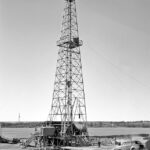Cross-country pipelines are an essential component of the energy and transportation infrastructure, providing a reliable and efficient means of transporting oil, gas, and other liquids and gases over long distances. These pipelines span hundreds, even thousands of miles, and are often constructed to transport energy resources from remote areas to markets and distribution centers.
In this article, we will explore the design and construction of cross-country pipelines, their benefits, and the environmental impacts associated with their construction and operation.
What is a Cross-Country Pipeline?
A cross-country pipeline is a large network of pipes used to transport liquids or gases over long distances, typically between cities, countries, or continents. These pipelines are typically constructed from materials such as steel and can range in diameter from a few inches to several feet.
Cross-country pipelines are used to transport a variety of substances, including crude oil, natural gas, refined petroleum products, water, and chemicals. They are often used as a more cost-effective and environmentally-friendly alternative to transporting these substances by truck, rail, or ship.
The construction and operation of cross-country pipelines require significant planning, engineering, and regulatory approvals. These pipelines must be designed to withstand the pressure and temperature changes that occur during transportation and must be monitored regularly for leaks or other safety concerns. Additionally, they must adhere to strict safety and environmental regulations to ensure the protection of people and the environment along the pipeline route.
Examples of Cross-Country Pipelines:
There are several examples of cross-country pipelines around the world. Some notable examples include:
- Trans-Alaska Pipeline System (TAPS): The TAPS is an 800-mile pipeline that transports crude oil from Prudhoe Bay to the port of Valdez in Alaska. It was constructed in the 1970s and is one of the largest pipeline systems in the world.
- Keystone Pipeline System: The Keystone Pipeline System is a 1,200-mile pipeline system that transports crude oil from Canada to refineries in the United States. It has been the subject of controversy due to environmental concerns and has faced multiple legal and regulatory challenges.
- Nord Stream Pipeline: The Nord Stream Pipeline is a 1,200-kilometer pipeline that transports natural gas from Russia to Germany through the Baltic Sea. It was constructed in 2011 and has faced criticism from some European countries over concerns about Russia’s control over energy supplies.
- West-East Gas Pipeline: The West-East Gas Pipeline is a 4,000-kilometer pipeline that transports natural gas from western China to eastern China. It is one of the longest pipelines in the world and was completed in 2004.
- Trans-Saharan Gas Pipeline: The Trans-Saharan Gas Pipeline is a proposed 4,400-kilometer pipeline that would transport natural gas from Nigeria to Europe through Algeria. The project has faced several delays due to political and economic challenges.
These are just a few examples of the many cross-country pipelines that exist around the world, transporting a variety of liquids and gases over long distances.
Cross-Country Pipeline Codes
Cross-country pipelines are designed and constructed to meet various codes and standards to ensure safety, reliability, and environmental protection. Here are some of the most commonly used codes and standards for cross-country pipelines:
- ASME B31.4: This code is published by the American Society of Mechanical Engineers (ASME) and provides standards for the design, construction, and operation of liquid pipelines.
- ASME B31.8: This code is also published by the ASME and provides standards for the design, construction, and operation of gas pipelines.
- API 5L: This code is published by the American Petroleum Institute (API) and provides standards for the manufacture of line pipes used in the transportation of oil, gas, and other fluids. Click here to know more about the material selection and quality management of cross-country pipelines.
- ISO 3183: This international standard specifies requirements for the manufacture of seamless and welded steel pipes for use in pipelines for the transportation of liquids and gases.
- ANSI/ASNT CP-189: This standard outlines guidelines for the qualification and certification of non-destructive testing (NDT) personnel, which is essential for pipeline inspections and maintenance.
- API 1169: This code provides standards for the certification of pipeline inspectors and covers areas such as pipeline construction, operations, and maintenance.
- PHMSA Pipeline Safety Regulations: These are regulations published by the Pipeline and Hazardous Materials Safety Administration (PHMSA) in the United States that establish minimum safety standards for the design, construction, and operation of pipelines.
Compliance with these codes and standards is essential for the safe and reliable operation of cross-country pipelines. Pipeline operators are responsible for ensuring that their pipelines meet these requirements and are regularly inspected and maintained to ensure continued compliance.
Design and Construction of Cross-Country Pipelines:
The design and construction of cross-country pipelines require careful planning, engineering, and regulatory approvals. The pipeline route is determined based on a variety of factors, including the location of the source and destination of the pipeline, the terrain, geology, and environmental considerations.
The construction of a cross-country pipeline involves several phases, including:
- Surveying and Planning: The pipeline route is surveyed and planned using topographical maps, geological surveys, and other data. Environmental, cultural, and community concerns are also considered during the planning process.
- Clearing and Grading: The pipeline route is cleared of vegetation and other obstacles. The land is then graded to create a flat surface for the pipeline to be installed.
- Trenching: A trench is dug along the pipeline route to accommodate the pipeline. The trench is typically several feet deep and several feet wide.
- Pipeline Installation: The pipeline is installed in the trench, and welded together to form a continuous length. The pipeline is then coated with a layer of protective material to prevent corrosion and other damage.
- Testing and Commissioning: The pipeline is tested for leaks and other defects before being commissioned for operation.
Benefits of Cross-Country Pipelines:
Cross-country pipelines provide several benefits over other forms of transportation. These benefits include:
- Cost-Effective: Cross-country pipelines are often more cost-effective than other forms of transportation, such as trucking or rail transportation.
- Efficient: Pipelines can transport large volumes of liquids and gases over long distances, providing an efficient means of transportation.
- Safe: Pipelines are generally considered a safe means of transporting liquids and gases, with a lower risk of accidents compared to other forms of transportation.
- Environmental Benefits: Pipelines are generally considered a more environmentally-friendly means of transportation compared to other forms of transportation. Pipelines can reduce greenhouse gas emissions by reducing the need for trucking and other forms of transportation.
Environmental Impacts of Cross-Country Pipelines:
The construction and operation of cross-country pipelines can have significant environmental impacts. These impacts include:
- Habitat Fragmentation: The construction of pipelines can fragment habitat, leading to the displacement of wildlife and the destruction of habitat.
- Soil Disturbance: The construction of pipelines can disturb the soil, leading to erosion and other environmental impacts.
- Water Pollution: The operation of pipelines can lead to spills and leaks, resulting in water pollution.
- Greenhouse Gas Emissions: The operation of pipelines can result in greenhouse gas emissions, contributing to climate change.
Conclusion:
Cross-country pipelines are an essential component of the energy and transportation infrastructure, providing a reliable and efficient means of transporting liquids and gases over long distances. The design and construction of these pipelines require careful planning, engineering, and regulatory approvals to ensure their safe and efficient operation. While pipelines provide several benefits, they can also have significant environmental impacts that need to be carefully managed and mitigated. By balancing the benefits and environmental impacts of cross-country pipelines, we can ensure a sustainable and reliable energy and transportation infrastructure for future generations.







Greeting
What is the productivity ratio between hot bend and standard piping for a given size please?